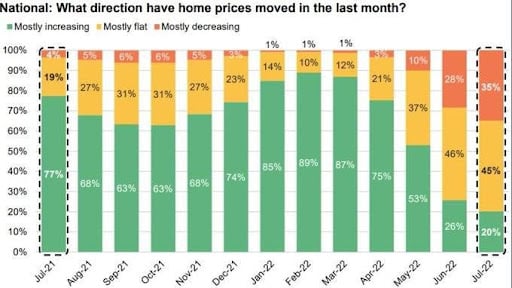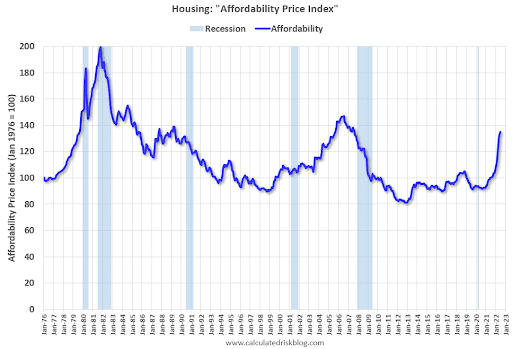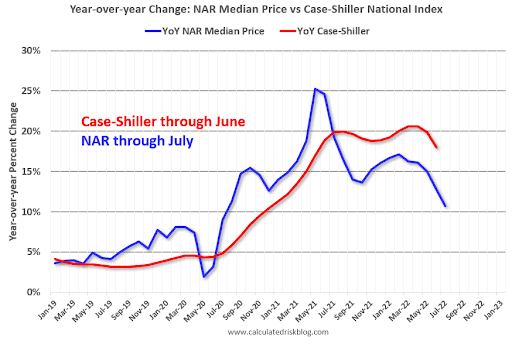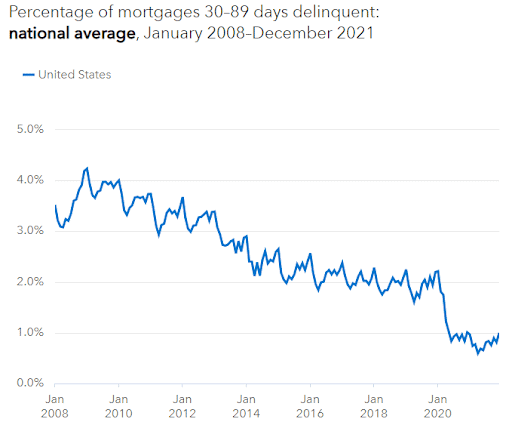It. Has. Begun.
2008 has returned, or at least that’s what many have been saying.
In July, for the first time in 32 months, prices declined from one month to the next.
One-Month Change in Median Home Price – Calculated Risk
Now, it should be noted that home values are still up 14.3% year-over-year, which is how prices are usually measured. This just means that the price of the average home sale in July 2022 was 0.77% less than in June.
What’s Happening In The Market
As would be expected, some markets were affected much more than others. San Jose, California, saw price declines of a full 10% from its peak, whereas Richmond, Virginia, only fell 1.1%. A handful of markets were still up in July as well. 35% of markets declined in July, whereas only 20% saw prices rise. And overall, the numbers were down.
 Direction of Home Prices Over the Last Month (July 2021-July 2022) – The Short Bear
Direction of Home Prices Over the Last Month (July 2021-July 2022) – The Short Bear
What’s important to keep in mind is that this was all but bound to happen. The market had been so absurdly hot that there was really only one way for it to go. Real estate prices had gone up almost 34% since the first quarter of 2020, after a decade of unprecedented housing appreciation.
Some people who claim that another 2008-like crash is around the corner like to point out that housing affordability is as bad as it’s been since the years leading up to the 2008 crash.
 Housing Affordability Price Index – Calculated Risk
Housing Affordability Price Index – Calculated Risk
At some point, people simply can’t afford to pay any more for housing, especially with interest rates going up and the Fed indicating they will continue to raise rates until inflation is back under control.
But it’s also important to keep things in perspective. The real estate market has declined in the past without it collapsing. 2008 is at the top of everyone’s mind in large part because it was the most recent recession, not because it is the most comparable to current market conditions.
In the grand scheme of things, prices would have to decline a lot just to wipe out the gains of the last few years. Indeed, housing prices fell 33% in The Great Recession, which, if it were to occur again, would only wipe out the gains real estate has made since the beginning of 2020!
 YoY Change: NAR Median Home Price vs. Case-Shiller National Home Price Index – Calculated Risk
YoY Change: NAR Median Home Price vs. Case-Shiller National Home Price Index – Calculated Risk
The thing that many forget is that 2008 was not just a significant decline in home values. It was a financial crisis predicated on a massive number of defaults, foreclosures, bank failures, and bailouts. In other words, prices falling was not a crisis in and of itself. Instead, prices going down triggered that crisis as it created a feedback loop as additional foreclosures caused home prices to decline further and so on as things spiraled out of control.
And while mortgage default rates are rising, they are still significantly below historical averages.
 Percentage of Mortgages 30-89 Days Delinquent Nationally (2008-2021) – Consumer Finance Protection Bureau
Percentage of Mortgages 30-89 Days Delinquent Nationally (2008-2021) – Consumer Finance Protection Bureau
As I noted in a previous piece, the only major similarity between 2008 and today is that housing prices are soaring. Virtually everything else is different and makes a collapse unlikely.
We are undoubtedly reaching the limits of affordability for Americans to buy a home, especially with rising interest rates. This by itself should cool the real estate market off (which we’re already seeing) and could cause a correction.”
“But everything else, from lending standards to economy-wide inflation to the ratio of fixed mortgages to adjustable-rate mortgages to the still massive housing shortage make a 2008-like collapse highly unlikely.
The NINJA loans and stated income approvals of the early to mid-aughts are mostly gone. The teaser rates are almost all gone and upwards of 95% of mortgages being taken out today are fixed rates. (And any loans taken out in the last few years were taken out with extremely low, fixed interest rates that will be unaffected by the Fed’s actions.) Subprime mortgage originations are less than 20% of what they were in 2006, and all-cash purchases are almost 50% higher.
In addition, homeowner equity is up almost 50% from 2006 (and over 150% from the trough of 2011), which provides (most) homeowners with a substantial cushion in case prices decline. Inflation is also quite high right now (8.3% for August), whereas it was quite low before the 2008-crash. This means that real estate prices can decline in real terms without substantially affecting the number of equity people have in their homes.
The government has also made it clear with the help they’ve provided to renters facing eviction after the moratorium expired that they will not tolerate another housing crisis and will spend whatever is necessary to prevent it, even if inflation goes back up because of it. And now that the Fed has raised rates above their historic lows, they have the room to drop rates if the market gets too hairy.
In other words, while real estate prices will almost certainly decline, the likelihood of a financial crisis is low, and the possibility that housing is what precipitates such a crisis is very low.
Final Thoughts
So, the answer to whether investors should panic is no.
That being said, the economy is far from good. Inflation is high, labor force participation is low, and growth has been negative for two straight quarters. Real estate prices are likely to decline over the next year, and interest rates will continue increasing for the foreseeable future.
It is a time for caution to say the least. Do not assume any appreciation in your analysis and bump up your interest rate expectations.
That being said, the extremely hot market we have had for the previous few years has made it substantially more challenging to source deals. As the market softens, more potential deals should start to open up.
Recessions don’t need to be catastrophic to open up opportunities. So be cautious but keep pounding the pavement as potential deals should become more plentiful in the coming months.
On The Market is presented by Fundrise

Fundrise is revolutionizing how you invest in real estate.
With direct-access to high-quality real estate investments, Fundrise allows you to build, manage, and grow a portfolio at the touch of a button. Combining innovation with expertise, Fundrise maximizes your long-term return potential and has quickly become America’s largest direct-to-investor real estate investing platform.
Learn more about Fundrise
Note By BiggerPockets: These are opinions written by the author and do not necessarily represent the opinions of BiggerPockets.

